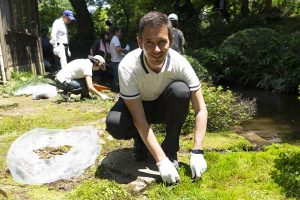Traditional Japanese gardens are famous all around the world for their perfectly manicured trees, balanced aesthetics and meticulous incorporation of nature into a anthropic environment. One of the most well known is Kenroku-en, in the city of Kanazawa, Japan, whose 8,750 trees, 183 species of plants, and myriad streams and ponds are any garden enthusiast’s Eden. An oasis in the concrete jungle, where people can feel immersed in nature.
Juan Pastor-Ivars is an expert in urban ecosystem development at the United Nations University Institute for the Advanced Study of Sustainability (UNU-IAS) in Kanazawa, Japan, and his passion for landscape architecture and Japanese gardens has brought him to an understanding of what green spaces can contribute to wellbeing of urban dwellers and how best to ensure that they continue to feature in a rapidly urbanizing world.
“If designed properly, urban green spaces can boost local well-being and reduce the ecological footprint of cities by providing vital services such as heat-island control and water management,” he says.
With its aging population and high rate of urbanization – over 91% of the Japanese population live in urban areas – Japan offers the world examples to follow as well as ones not to when it comes to urban greening.
What kindled your interest in urban green spaces?
As a researcher with a background in landscape architecture, I started looking into Japanese gardens from an architect’s perspective, seeking to understand how elements of nature surrounding the city were being incorporated in gardens and then into the very center of the city itself. The idea of dropping a piece of nature into the city captivated me.
At the same time, I also realized that because of Japan’s shrinking population, which leads to many abandoned buildings and plots of land, there was a need to transform abandoned gray infrastructure into green spaces and nature-based solutions.
Why is it important to develop urban ecosystem services?
The main purpose is to restore the harmony between humans and nature because nature in cities has been disappearing due to rapid urbanization and nature fragmentation.
First, we need to conserve existing green urban spaces, whether this be traditional gardens, sacred forests or small private gardens. The second strategy is about transformation, and therefore creating new green infrastructure by transforming abandoned gray infrastructure. Finally, the key is to merge these two approaches.
What can green spaces in cities contribute to human and planetary wellbeing?
The relationship between humans and nature has always been a central part of our culture as humans and although it varies greatly depending on the ontology of each period cities tend to develop around natural resources such as rivers or hills.
With rapid urbanization nature in the cities tends to disappear and the relationship becomes one of colonizing nature.
This is a problem because as more and more people live in cities the only nature they will have easily accessible will be that which is found in the cities themselves. This gives green urban spaces an added importance as they can help maintain a connection between humans and nature.
There are many studies on the impacts that nature in cities can have on things such as place belonging and social cohesion, not to mention the environmental benefits, including a reduced heat island effect, and biological production. Urban green spaces can become important habitats for wildlife or natural processes such as pollination, and of course they can contribute to climate change mitigation by removing CO2 from the atmosphere and storing it in the ground.
So, it’s not only about the direct benefits to the well-being of city dwellers but also the benefits that they can bring for animals and the environment.
How does nature in cities influence the culture and attitudes of its inhabitants?
The culture of people living in cities is very much related to the surrounding nature. In Kanazawa for example this connection is very clear in the arts, crafts and traditions that have emerged. From the gardens to local crafts such as using natural dyes derived from natural resources in the area.
Culture is also visible in the regulations and landscape connections that cities enact. Once again, Kanazawa was one of the first Japanese cities to enact landscape protection regulations 50 years ago to protect the natural corridors, water canals and landscaping inside the city. A heritage that was added two six years ago when the city passed biological control diversity regulations to protect the link between culture and nature.
What lessons can be transferred from Japan’s approach to green urban areas?
In Europe, broadly speaking, the public sector is stronger than the private sector. This means that local governments have more power to implement the master plan of cities because they have the tools to develop land for public purposes.
In contrast, the private sector is stronger than the public one in Japan. This relates to many green urban areas such as traditional Japanese gardens, sacred forests which are often linked to shrines and temples, and private gardens. In this context there is a need to develop tools that allow for land transformation so that we can improve urban greening in cities. In Japan this often means leveraging strong local communities that have developed successful examples at the neighborhood level for land use or transformation.
Are there specific designs of urban green spaces that bring the most benefits?
It’s not about what design you go for, the important thing is that you go for nature-based solutions. There are many different types of urban green spaces and each place will have a solution that is more suited to its context. The priority is that they can be easily maintained and used by urban communities now and in the future.
Citizens have to actively collaborate to conserve the nature that exists in cities. All of us gain benefits from it so we all have a responsibility to maintain the new green commons.
 Dr. Juan Pastor-Ivars is a researcher with the UNU-IAS Operating Unit Ishikawa / Kanazawa (OUIK). His areas of academic expertise are the fields of architecture, urban planning, landscape architecture, and ecology. His research focuses on the sustainable conservation and resilient development of urban ecosystem services.
Dr. Juan Pastor-Ivars is a researcher with the UNU-IAS Operating Unit Ishikawa / Kanazawa (OUIK). His areas of academic expertise are the fields of architecture, urban planning, landscape architecture, and ecology. His research focuses on the sustainable conservation and resilient development of urban ecosystem services.






